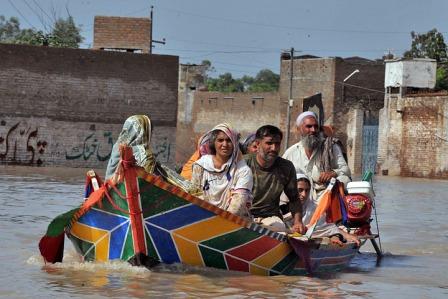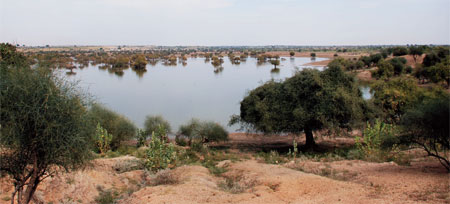Rainfall and other forms of Precipitation
"Media getting sensitive towards water and sanitation issues in North Bihar"-Recent updates from the work of Megh Pyne Abhiyan
Posted on 10 May, 2011 06:41 PM. I had shared how Megh Pyne Abhiyan through its local partner - Samta in Khagaria (supported by Gramyasheel, Kosi Seva Sadan, Ghoghardiha Prakhand Swarajya Vikas Sangh and Water Action) has been able to collaborate with the district administration to mainstream issues concerning water and sanitation for the flood prone areas.
In Supaul, the district administration requested our local partner, Gramyasheel to write about alternative drinking water practices (appropriate for the district) for a publication - Supaul Zila Ki Smarika, brought out by the district administration. A definite indication of the WATSAN practices being recognized at the local level. Though the collaboration is an ongoing process which would lead to positive results if time, ideas and perseverance are invested appropriately.
Groundwater: From mystery to management - An article by TN Narasimhan
Posted on 22 Apr, 2011 12:07 PMGroundwater has been used for domestic and irrigation needs from time immemorial. It is a component of the hydrological cycle, vital for human sustenance. Unlike surface water, groundwater cannot be readily observed. Consequently, it was long considered to be mysterious or even occult in nature, influencing legal decisions relating to groundwater ownership and use.
Proposal for groundwater recharge in National Capital Region - A report by SK Sharma and Green Systems
Posted on 22 Apr, 2011 11:53 AMIt also explains the various laws that have been put in place to increase groundwater replenishment.
Country to have normal monsoon this year - PIB release
Posted on 21 Apr, 2011 03:21 PMReleasing Long Range Forecast for coming June to September period, Union Minister for Science and Technology and Earth Sciences, Shri Pawan Kumar Bansal said, “The rainfall for the country as a whole is most likely to be normal i.e. 96-104% of Long Period Average (LPA). Quantitatively, monsoon season rainfall is likely to be 98% of the LPA with a model error of + 5%.
Heavy rains and dry lands don t mix: Reflections on the 2010 Pakistan flood - Article from NASA Earth Observatory
Posted on 16 Apr, 2011 03:42 PM Flooding forced millions of Pakistanis to flee their homes in July and August 2010.
Flooding forced millions of Pakistanis to flee their homes in July and August 2010.
The summer of 2010 was different. In July and August, rain fell over most of Pakistan and persisted in some places for weeks.
Lingering floods in Pakistan - Updates from Earth Observatory
Posted on 15 Apr, 2011 09:49 AM
A combination of factors, including La Niña and a strange jet stream pattern, caused devastating floods. The Indus River rapidly rose, and a dam failure in Sindh Province sent part of the river down an alternate channel. The resulting floodwater lake lingered for months, leaving crops, roads, airports, even entire communities underwater.
Water turns the tide - A barren district of Rajasthan is seeing development, thanks to rains last year and floods in 2006
Posted on 12 Apr, 2011 11:31 AMArticle and Image Courtesy: Down To Earth
Author:
A barren district of Rajasthan is seeing development, thanks to rains last year and flood in 2006.
 Administration has revived a man-made pond in Nagarda village that was drying up.
Administration has revived a man-made pond in Nagarda village that was drying up.
Photo: Sayantoni Palchoudhuri
World Water Day in Kerala- Call to address issues of water security
Posted on 07 Apr, 2011 05:52 PMCentre for Water Resources Development and Management (CWRDM) organised a panel discussion at Sasthra Bhavan on Saturday, 19th March 2011, in connection with the celebration of World Water Day which falls on March 22.
Review of Krishna Water Disputes Tribunal - A report on Krishna river water allocations
Posted on 08 Mar, 2011 04:42 PMThis is a review of KWDT-2 report analysing how it has failed to protect the long term sustainable productivity and ecology of the river basin. It has also failed to understand the water allocations done by previous KWDT-1. KWDT-2 also negated the earlier KWDT-1 allocations at the same time categorically stating that it cannot change water use allocations of previous award.
Steps to create awareness about rainwater harvesting and encouragement to states for implementation of rainwater harvesting projects - PIB release
Posted on 25 Feb, 2011 10:41 AMGiving this information in written reply to a question in the Lok Sabha on the average annual rainfall and rainwater harvesting, Shri Salman Khurshid, Minister of Water Resources, said that rain water is harvested through surface storages and recharge of ground water.The total storage capacity created through major and medium projects is around 225 BCM. The data on quantum of rainwater harvested through groundwater recharging is 433 BCM. Ministry of Water Resources does not maintain the data on quantum of water harvested due to manmade structures separately.It is estimated that the water utilized in 2010 is about 681 BCM.





